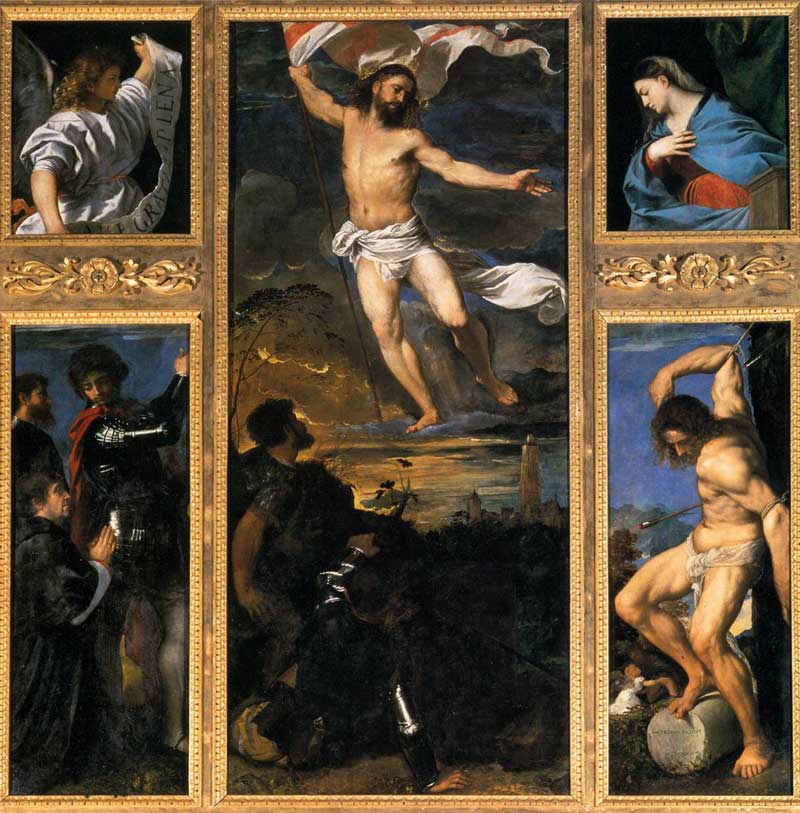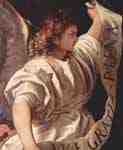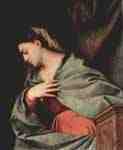
----
. Τιτσιάνο
----
Fine Art Prints | Greeting Cards | Phone Cases | Lifestyle | Face Masks | Men's , Women' Apparel | Home Decor | jigsaw puzzles | Notebooks | Tapestries | ...
---
The Averoldi Polyptych is a painting by the Italian late Renaissance painter Titian, dating to 1520–1522 and in the basilica church of Santi Nazaro e Celso in Brescia, northern Italy.
It is signed "Ticianus Faciebat / MDXXII" on the column of the panel with St. Sebastian.
 Averoldi - Altarpolyptychon : Resurrection
Averoldi - Altarpolyptychon : Resurrection
 Averoldi - Altarpolyptychon : Saints and Donors
Averoldi - Altarpolyptychon : Saints and Donors
 Averoldi - Altarpolyptychon : Angel of the Annunciation
Averoldi - Altarpolyptychon : Angel of the Annunciation
 Averoldi - Altarpolyptychon : St. Sebastian
Averoldi - Altarpolyptychon : St. Sebastian
 Averoldi - Altarpolyptychon : Virgin of the Annunciation
Averoldi - Altarpolyptychon : Virgin of the Annunciation
History
The work was commissioned by Altobello Averoldi, papal legate in Venice, to Titian at the time he was the official painter of the Republic of Venice. The work was delivered in 1522, as testified by Titian's signature in the lower right panel. The large polyptych was placed at the high altar of the church of Santi Nazaro e Celso of Brescia, then part of the Venetian mainland possessions, replacing another altarpiece by Vincenzo Foppa (of which now a Nativity of Jesus remains in the church of Santa Maria Assunta at Chiesanuova, as well as two side panels in the Pinacoteca Tosio Martinengo).
A first version of the St. Sebastian panel was offered to Alfonso d'Este of Ferrara as a compensation for his late in the realization of the Bacchanalia. The Duke declined the offer, and the early St. Sebastian was perhaps sent to Mantua, where one such painting is mentioned among the artworks sold by the Gonzaga to Charles I of England, although it is no more known afterwards.[1]
Averoldi subsequently also started to complain about the lateness of delivery.
Description
The use of compartment-divided polyptych, a solution rather old fashioned for the time, was surely an explicit demand of Averoldi. Titian obtained anyway a certain degree of unity, although not a spatial or architectural one as in the 15th century polyptychs: the Veneto painter adopted instead a chromatic-dynamic and light convergence towards the central scene.[2]
The panels are:
Resurrection of Christ, 278x122 cm
Saints Nazarius and Celsus with Donor, 170x65 cm
Saint Sebastian, 170x65
Angel of the Annunciation, 79x65 cm
Annunciation of the Virgin, 79x65 cm
The work inspired several Brescian Renaissance painters, including Savoldo and Moretto[3]
The Martyrdom of Saint Sebastian
Resurrection
The central scene depicts a triumphant and blazing Christ above a dawn dark yellow and grey sky, who holds the Crusader banner as an emblem of the Christian Catholic church. Under him is a group of soldiers with armors.
The work shows the influence of Raphael's works such as the Transfiguration (the centripetal position of Christ) and the fresco of the Deliverance of Saint Peter for the quasi-night atmosphere[1] Another possible influence is that of Danube school, in details such as the landscape illumination and the northern European fashion of the ideal Jerusalem in the background.[3]
Saints Nazarius and Celsus with Donor
The left panel show the saints Nazarius and Celsus, to which the church housing the altar was dedicated, on a gloomy background. Nazarius wear a shining armor, while his disciple, Celsus, is behind him. The kneeling donor is portrayed from profile, and is stylistically reminiscent of the depiction of Sigismondo de' Conti in Raphael's Madonna of Foligno. The influence of Titian's master, Giorgione, is also visibile in the calm atmosphere and the dull colors.[3]
Preparatory drawing for St. Sebastian, now in Frankfurt's Städel.
Saint Sebastian
The right panel shows the traditional Martyrdom of Saint Sebastian, although in this case the saint is depicted in a rather contorted position which likely derived from Michelangelo's Punishment of Aman in the Sistine Chapel ceiling, or from Raphael's Fire of Borgo also in the Vatican.[1] The arms are tied to a trunk at different heights, while the legs are also differently articulated due to the presence of a column section.
The saint's face resembles that of the Christ in the central panel, as well as that of Titian, who was thirty at the time.[1]
In the background is an angel, who points at Sebastian and talks with Saint Roch: prayers to both saints were invoked as a protection against the plague, and Roch's uncovered legs show the characteristic lesions.
Two preparatory drawings of the panel exist: one (16.2 x 13.6 cm) is at the Kupferstichkabinett of Berlin, and another (18.3 x 11.5 cm) is in the Städel of Frankfurt.
Angel of the Annunciation
Annunciation
The two upper panels show the Annunciation, with the angel on the left and the Virgin on the right, according to a scheme dating to the Middle Ages. Titian painted the two figures under a powerful light, in particular the angel which is illuminated from behind.
His figure is unrolling a cartouche with the Gospel words Ave Maria Gratia Plena.
See also
List of works by Titian
Notes
Description page at the Università Cattolica del Sacro Cuore website
Cecilia Gibellini, ed. (2003). Tiziano. Milan: Rizzoli.
Zuffi, Stefano (2008). Tiziano. Milan: Mondadori Arte. ISBN 978-88-370-6436-5.
References
Valcanover, Francesco (1969). L'opera completa di Tiziano. Milan: Rizzoli.
----
Fine Art Prints | Greeting Cards | Phone Cases | Lifestyle | Face Masks | Men's , Women' Apparel | Home Decor | jigsaw puzzles | Notebooks | Tapestries | ...
----
Retrieved from "http://en.wikipedia.org/"
All text is available under the terms of the GNU Free Documentation License


